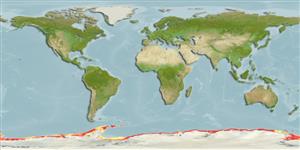>
Perciformes/Notothenioidei (Icefishes) >
Nototheniidae (Cod icefishes) > Trematominae
Etymology: Trematomus: Greek, trematos = hole + Greek, tomo = section, cut (Ref. 45335); scotti: Named after Captain Robert Falcon Scott, leader of British National Antarctic Expedition (Ref. 11892).
More on author: Boulenger.
Issue
The genus Pseudotrematomus is a synonym of Trematomus, which is confirmed by a molecular study to be published (J.-C. Hureau, pers. comm. 08 Jun. 2010).
Environment: milieu / climate zone / depth range / distribution range
पारिस्थितिकी
समुद्री ड़िमरसल; गहराई सीमा 20 - 793 m. Polar; 60°S - 78°S
Southern Ocean: South Shetland, South Orkney islands, Ross Sea, Breid Bay, Weddell Sea and Antarctic Peninsula (Ref. 11892).
आकार / वज़न / Age
Maturity: Lm ? range ? - ? cm
Max length : 24.7 cm TL पुल्लिंग / अलिंग; (Ref. 124149); अधिकतम प्रकाशित वज़न: 124.60 g (Ref. 124149)
Adults feed primarily on polychaetes, euphausiids, amphipods, together with a lesser amount of isopods. Larval pelagic phase is long (Ref. 89434).
Dewitt, H.H., P.C. Heemstra and O. Gon, 1990. Nototheniidae. p. 279-331. In O. Gon and P.C. Heemstra (eds.) Fishes of the Southern Ocean. J.L.B. Smith Institute of Ichthyology, Grahamstown, South Africa. (Ref. 5179)
IUCN Red List Status (Ref. 130435)
Threat to humans
Harmless
Human uses
मात्स्यिकी: कोई रुचि बग़ैर
अधिक जानकारी
सहयोगीयोतस्वीरेStamps, Coins Misc.ध्वनिसिगुयटिरारफ्तारतैरने के प्रकारगिल क्षेत्रOtolithsदिमागदृष्टि
साधन
Special reports
Download XML
इंटरनेट स्रोत
Estimates based on models
Preferred temperature (Ref.
123201): -1.8 - 0.9, mean -0.9 °C (based on 584 cells).
Phylogenetic diversity index (Ref.
82804): PD
50 = 0.5005 [Uniqueness, from 0.5 = low to 2.0 = high].
Bayesian length-weight: a=0.00479 (0.00320 - 0.00715), b=3.19 (3.07 - 3.31), in cm total length, based on LWR estimates for this species & Genus-body shape (Ref.
93245).
Trophic level (Ref.
69278): 3.2 ±0.2 se; based on diet studies.
Generation time: 11.0 ( na - na) years. Estimated as median ln(3)/K based on 2
growth studies.
लौटाव (Ref.
120179): निम्न, न्यूनतम जनसंख्या दुगनी होने का समय 4.5 - 14 वर्ष। (Preliminary K or Fecundity.).
Fishing Vulnerability (Ref.
59153): Moderate to high vulnerability (47 of 100).
Nutrients (Ref.
124155): Calcium = 39.9 [21.9, 100.2] mg/100g; Iron = 0.484 [0.206, 0.969] mg/100g; Protein = 17 [16, 18] %; Omega3 = 0.44 [0.23, 0.82] g/100g; Selenium = 13.6 [5.4, 30.8] μg/100g; VitaminA = 23.9 [5.1, 116.7] μg/100g; Zinc = 0.653 [0.422, 1.002] mg/100g (wet weight); based on
nutrient studies. 